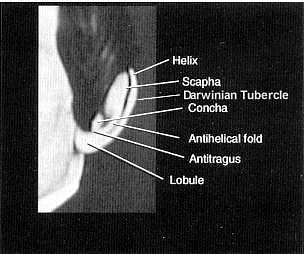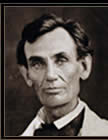by Claude N. Frechette, M.D.
Facial Characteristics of the Kaplan Daguerreotype
A great number of similarities are readily seen, especially when each segment of the Kaplan image is examined separately. As will be pointed out later, a number of subtle details are not captured by prints made from the daguerreotype, but are clearly visible under loop magnification of the actual daguerreotype. (A characteristic of daguerreotypes is of significance here. The surface of a daguerreotype is covered with a thin film of a mercury/silver amalgram that affects light refraction. This gives the viewer a sense of depth; but when the daguerreotype is photographically reproduced, the image in the resulting print loses detail and seems to flatten out.)
The Upper Face (Figure 5)
In the Kaplan daguerreotype, the hair appears to be dark and thick. The style is identical to that worn by Lincoln in his early and late portraits. There is a characteristic "tuft" on the right, above the ear. The top of the left ear is totally covered by hair that is purposely combed forward, as it is in many Lincoln photographs. The forehead is high and broad, and the hairline in the left temporal region is also identical to those in later photographs. The skin here appears to be rough, with numerous discontinuous lines that suggest the advent of heavy wrinkles.
Figure 5
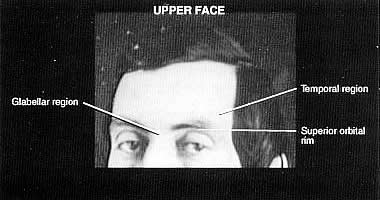
The glabellar region (between the eyebrows, above the nose) appears to be free of hair. There are two discrete ascending and oblique shadows that anticipate the older Lincoln's frown lines.
The eyebrows are heavy and have two different hair patterns, similar to the eyebrows in the later photographs of Lincoln. The medial (inner) portion is dark and linear whereas the lateral (outer) half is more bushy. The left eyebrow, the one fully seen, extends over the entire length of the superior orbital rim.
To round out this discussion of the forehead features in the Kaplan daguerreotype, let me present another "similarity." As mentioned earlier the neurologist, Dr. Kempf, found evidence of a depressed skull fracture in the Lincoln life mask. Visual evidence of that injury is absent in the Kaplan, nor is it to be found in any other known Lincoln photographic image.
The Central Face (Figure 6)
The gentleman in the Kaplan has a rare condition, bilateral ptosis {24, 25}(drooping eyelids), evident in many photographs of Lincoln. Two other findings are characteristic: the lateral extension of the free border of the upper lid beyond the outer corner of the eye (lateral commissure), and the well-defined upper and lower superficial heads of the medial canthal tendon, which attaches the inner corner of the eye commissure {26}. The upper segment is easily seen in all Lincoln portraits, whereas the lower branch is only occasionally seen because of shadows or poor photographic depth-of-field. Photographic representation of these features are rarely seen in pictures of individuals, but are seen in known Lincoln portraits and in the Kaplan image.
Figure 6
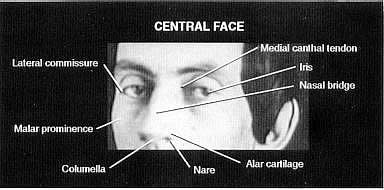
There is a phenomenon known as Hirschberg's test of corneal light reflex, a white dot seen in both eyes that reflects the prime source of illumination. Usually, the dots are located in the same spot in both eyes (with regard to the iris, or "black of the eye.") However, in the Kaplan, and in the other Lincoln images, this is not true. The left eye's gaze is in fact slightly more lateral, placing the dot in that eye toward the inside.
The region under the left eye is marked by two dark spots, the upper one of which is found in several of the Lincoln portraits.
A few of Lincoln's contemporaries recorded their observations of the deep-set nature of Lincoln's eyes. This is a characteristic of his photographic images, as well as the Kaplan.
The left malar (cheekbone) prominence is well-outlined and delineated by a shadow that descends onto the cheek and turns inward toward the labial commissure (corner of mouth). This would suggest the heavy bone structure typical of a massive physique such as Lincoln's. The nose is long, broad, and well-defined. The nasal bridge is wide. Although a shadow on the right side of the nose gives the impression that the dorsum is humped, close examination of the daguerreotype shows that the nose is, in reality, only slightly bossed. The nares are delicate and well-defined. The alar cartilage (the cartilage supporting the nostrils) do not appear to be over-sized. The skin appears to have a fine quality. Naturally, this is not true in later Lincoln portraits, where the skin appears to be heavier due to wrinkling, a result of the aging process.
In the Kaplan, the columella (the skin between the nostrils) is rather broad, and the collumellar-labial angle (the angle it makes with the upper lip) appears to be close to 90 degrees; both of these features are seen in the later Lincoln images.
The Lower Face (Figure 7)
The philtral columns (the edges of the vertical groove in the upper lip) are well-marked, almost parallel, and extend to the base of the nose. The Cupid's bow (the mid-segment of the upper lip) is delicately formed and harmonious. The vermilion (the red area of the lip) is rather narrow at the lateral aspect of the lip and seems to end short of the commissure (the corner of the mouth), presenting a crease. The crease is a wrinkle that is seen directed downward; both of these characteristics are life-long and are seen in later Lincoln images.
Figure 7
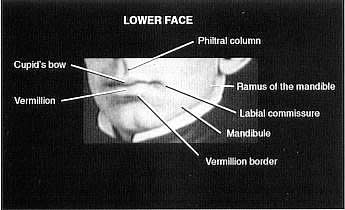
The shadow of the left naso-labial crease (one of the two creases that "calipers" down from the nose to frame the upper lip) extends from the superior aspect of the nares to the modiolus. (The modiolus is a point outside and slightly above the corner of the mouth where several muscles join.) In some people this point would be marked by a dimple, but in Lincoln, it is seen as a vertical crease. The modiolus is not seen on the left side of the Kaplan face, but is clearly seen on the right.
A faint circular shadow appears at the lower portion of the middle third of the right nasolabial crease, which is the precise location of Lincoln's characteristic nevus (prominent right mole) seen in later Lincoln images. There is also a highlight, or faint shadow, more to the middle and below the nevus shadow, at the vermilion border (the line demarcating the red and white portions of the lip) that probably is another mole, corresponding to a similar skin lesion in several Lincoln photographs.
Dr. Kempf also observed, "Further examination of the face shows that the left half of the upper lip is somewhat thicker than the right.", an unusual feature which is also evident in the Kaplan image.
The lower lip is full and appears to protrude beyond the free margin of the upper lip throughout. This appears to be more significant laterally (at the ends). There is a blemish under the left commissure that is not found in other Lincoln pictures, and could be a 'cold sore' Lincoln had at the time the daguerreotype was made. There is an ascending crease line at about 70 degrees on the lower left lip of the man in the Kaplan, identical to that of later images of Lincoln.
The prominent chin begins with a distinctive horizontal, midline shadow that demarcates it from the pouting lower lip. The chin appears asymmetrical. A short vertical crease is off-center, and turns to the subject's left distally (as it moves down). The left half of the chin appears smaller than the right. This peculiarity as well as the whole face's (deformed) morphological curve (exactingly described by Dr. Kempf) is more obvious when the image is viewed upside down. The jawline (mandible) is well-defined and broad. The mandibular (lower jaw) angle is sharp. As the ramus of the mandible turns upward toward the ear, it (the height of the jawbone) appears to be shorter in a Kaplan daguerreotype print than in Lincoln photographs; however, in the actual Kaplan daguerreotype, it is the same.
The Ears (Figure 8)
The ears appear to be prominent, especially at the superior pole. Along the free margin (the running edge, or border) of the concha (the shell-like opening of the ear), the anti-helical fold is well-defined, but its upper segment is absent. (The anti-helical fold is the bend in the wings of the ears that runs from the concha to the superior pole, molding the ear so that it conforms to the shape of the head.) Especially noteworthy is a discrete Darwinian tubercle on the edge of the scapha (the area behind the concha that leads up to the helix, or curved-over rim of upper ear){see Meserve #1 and Mellon #s 5, 6, 8, 11, 22, 26, and 29 for other examples}. The ear lobule hangs free and is close to the neck.
Figure 8
